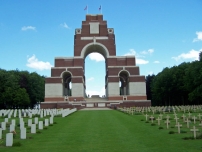| First Name: | William Charles | Last Name: | ELLWICK | |
|---|---|---|---|---|
| Date of Death: | 15/09/1916 | Lived/Born In: | Nunhead | |
| Rank: | Sergeant | Unit: | London6 | |
| Memorial Site: | Thiepval Memorial, France | |||
Current Information:Enlisted-London
The Battle of the Somme (July-November, 1916) By the beginning of September, 1916, the Battle of the Somme had been raging for two months. Thousands of men had already been killed or wounded or were simply missing, never to be seen again and and just a few square miles of the French countryside, all in the southern part of the battlefield, had been captured from the enemy. Mistakes had been made by the various commanders and would be continued to be made but there was no turning back as the British, Australians, South Africans, New Zealanders and Canadians carried on battering away at the German defences in the hope of a breakthrough, So it continued all the way through to November with nearly every battalion and division then in France being drawn into it at some stage. In the end the German trenches had been pushed back a few more miles along most of the line but the cost in lives had been staggering. By the end of the fighting in November, 1916, British Army casualties numbered over 400,000, killed, wounded and missing. On 15th September, 1916, the offensive on the Somme was renewed with a full scale attack on the German 3rd line of defences. Four Army Corps were used on a front that stretched from Combles, through the village of Flers and on to Courcelette.. The artillery barrage that preceded this attack was more concentrated than that on 1st July and the attack itself was more successful. The villages of Flers, Martinpuich and Courcelette were captured and the enemy was finally pushed out of High Wood, but the breakthrough was not achieved and the reality was that when the battle ended on 22nd September, the front line had just been moved forward a mile or so. The battle is notable for being the first time that tanks were used. 47th (London) Division attacked on 15th September with 140 and 141 Brigades. While 141 Brigade assaulted directly into High Wood, 140 Brigade attacked on their right. At 6.20am 7th London and one company from 15th London moved forward just to the east of the wood and without meeting too much opposition reached the Switch Line, a German trench on the reverse side of the slope. They dug in just beyond it. 8th London then moved forward and managed to gain a foothold in some, but not all, of the second objective, the Starfish Line. This was the signal for 6th London, the 4th battalion of 140 Brigade, to attack the 3rd and final objective, the Flers Line. Moving off at 8.30am they immediately ran into trouble from those parts of the Starfish Line that had not been captured and also from the eastern side of High Wood, which had not yet been cleared of the enemy. On their right the New Zealanders had also been held up so as they advanced, 6th London were hit by machine-gun fire from both flanks as well as from in front. In places the Germans were rising up out of their trenches to direct their fire more directly on them. What was remarkable was that despite all this they managed to capture a German strongpoint called the ‘Cough Drop’ and some even went on to reach the Flers Line. But by now their numbers had been greatly reduced and they were unable to stay there. Among the many casualties suffered by 6th London on 15th September was William Ellwick. |
||||
| « Back to Search Results | ||||
| If you think any of the information shown here is incorrect, Click Here to submit your amends and comments | ||||




